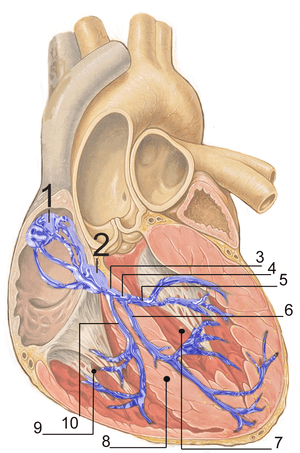Pre-excitation syndrome
Pre-excitation syndrome is a heart condition in which part of the cardiac ventricles are activated too early.[1] Pre-excitation is caused by an abnormal electrical connection or accessory pathway between or within the cardiac chambers. Pre-excitation may not cause any symptoms but may lead to palpitations caused by abnormal heart rhythms It is usually diagnosed using an electrocardiogram, but may only be found during an electrophysiological study.[2] The condition may not require any treatment at all, but symptoms can be controlled using medication or catheter ablation.
| Pre-excitation syndrome | |
|---|---|
 | |
Electrical conduction system of the heart. (Accessory pathways not shown.)
| |
| Specialty | Cardiology |
Types
Several types of pre-excitation syndrome have been described.[3]
| Type | Conduction pathway | PR interval | QRS interval | Delta wave? |
| Wolff-Parkinson-White syndrome | Bundle of Kent (atria to ventricles) | short | long | yes |
| Lown-Ganong-Levine syndrome | "James bundle" (atria to bundle of His) | short | normal | no |
| Mahaim-type | Mahaim fibers | normal | long | no |
Pathophysiology
Normally, the atria and the ventricles are electrically isolated, and electrical contact between them exists only at the "atrioventricular node". In all pre-excitation syndromes, at least one more conductive pathway is present. Physiologically, the normal electrical depolarization wave is delayed at the atrioventricular node to allow the atria to contract before the ventricles. However, there is no such delay in the abnormal pathway, so the electrical stimulus passes to the ventricle by this tract faster than via normal atrioventricular/bundle of His system, and the ventricles are depolarized (excited) before (pre-) normal conduction system.
References
- Handbook of cardiac electrophysiology : a practical guide to invasive EP studies and catheter ablation. Murgatroyd, Francis D. London: ReMEDICA Pub. 2002. ISBN 9781901346374. OCLC 48363139.CS1 maint: others (link)
- Josephson, Mark E. (2015-08-10). Josephson's clinical cardiac electrophysiology : techniques and interpretations. Preceded by: Josephson, Mark E. (Fifth ed.). Baltimore, MD. ISBN 9781496326614. OCLC 938434294.
- "General principles of asynchronous activation and preexcitation". Retrieved 2009-08-12.